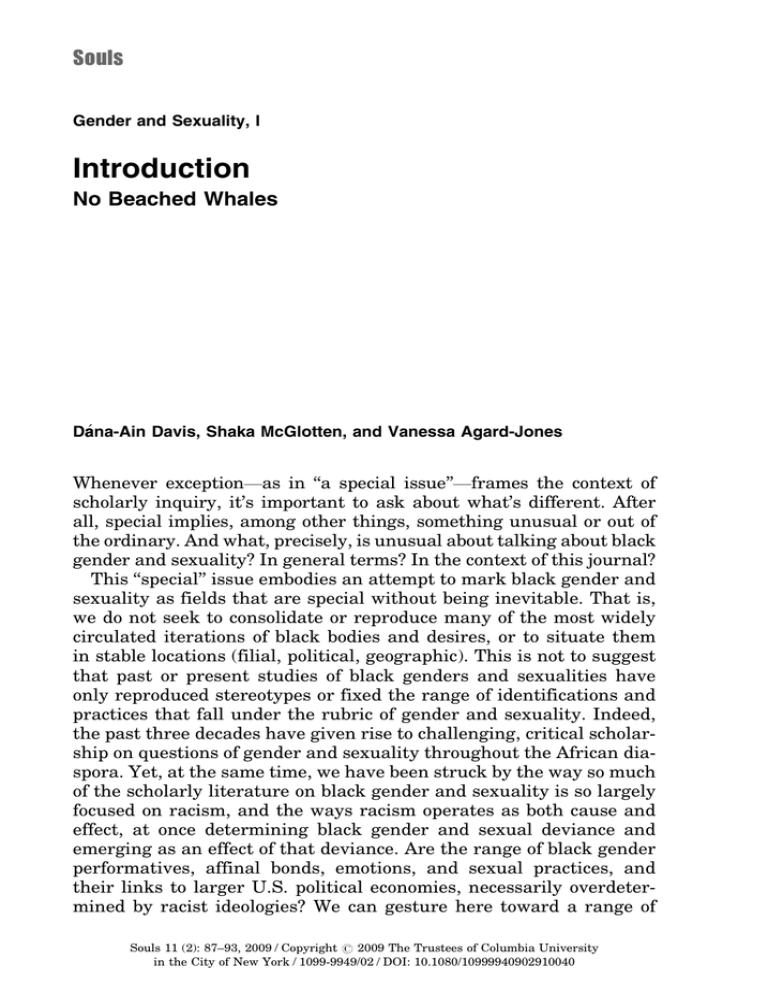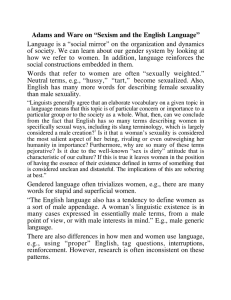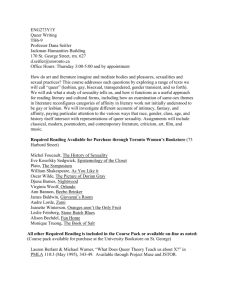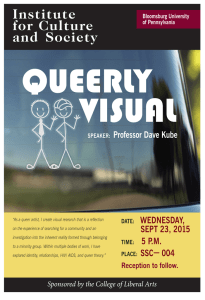
Souls
Gender and Sexuality, I
Introduction
No Beached Whales
na-Ain Davis, Shaka McGlotten, and Vanessa Agard-Jones
Da
Whenever exception—as in ‘‘a special issue’’—frames the context of
scholarly inquiry, it’s important to ask about what’s different. After
all, special implies, among other things, something unusual or out of
the ordinary. And what, precisely, is unusual about talking about black
gender and sexuality? In general terms? In the context of this journal?
This ‘‘special’’ issue embodies an attempt to mark black gender and
sexuality as fields that are special without being inevitable. That is,
we do not seek to consolidate or reproduce many of the most widely
circulated iterations of black bodies and desires, or to situate them
in stable locations (filial, political, geographic). This is not to suggest
that past or present studies of black genders and sexualities have
only reproduced stereotypes or fixed the range of identifications and
practices that fall under the rubric of gender and sexuality. Indeed,
the past three decades have given rise to challenging, critical scholarship on questions of gender and sexuality throughout the African diaspora. Yet, at the same time, we have been struck by the way so much
of the scholarly literature on black gender and sexuality is so largely
focused on racism, and the ways racism operates as both cause and
effect, at once determining black gender and sexual deviance and
emerging as an effect of that deviance. Are the range of black gender
performatives, affinal bonds, emotions, and sexual practices, and
their links to larger U.S. political economies, necessarily overdetermined by racist ideologies? We can gesture here toward a range of
Souls 11 (2): 87–93, 2009 / Copyright # 2009 The Trustees of Columbia University
in the City of New York / 1099-9949/02 / DOI: 10.1080/10999940902910040
88
^
Souls
April^June 2009
work that cuts across historical and interdisciplinary sites (Moynihan
1965; Gilman 1985; Cosby and Poussaint 2007). While we are attuned
to the ongoing salience of racism, we did not explicitly seek out work
that grappled with it as its central analytic lens. Rather, we sought to
capitalize on what we view as an ongoing disruptive momentum in
black studies and emergent black queer studies. Our goal was to
locate the strongest new scholarship in black gender and sexuality
both in the United States and abroad. And while normative heterosexualities certainly fall under this rubric (see below), we were more
interested in, among other things, new definitions of the alphabet
soup: lesbian, gay, bisexual, transgender, queer and intersexed
LGBT(Q,I); critical approaches to activism and sexuality; neoliberalism and black sexuality; race, sexuality, and affect; sexual citizenship; and=or gender and performativity.
To say that we were interested in work that didn’t reproduce black
genders and sexualities as overdetermined by racist ideologies is not
to say that we were especially interested or invested in what is
increasingly, though sometimes mistakenly, called a post-racial politics. Rather, we sought lateral movements away from those trends in
which black bodies and desires have been made congruent with, or in
resistance to, cultural pathology and social deviance. We sought to
sidestep some of the limits of representational analysis that have plagued scholars and critics of black experiences, the problematic that,
for example, led Hortense Spillers (2003) to make her famous comment that ‘‘black women are the beached whales of the sexual universe, unvoiced, unseen, not doing, awaiting their verb (emphasis
ours). Their sexual experiences are depicted, but not often by them,
and if and by the subject herself, often in the guise of vocal music,
often in the self-contained accent and sheer romance of the blues.’’
(153). The equation of black sexuality with pathology has led others
to engage in an ambivalent politics of refusal, in which representation
is blocked, as in Lorna Simpson’s famous image ‘‘Guarded Conditions’’ in which a black woman stands with her back to the camera.
Of course the limits of this are painfully clear: if no image of black
gender or sexual difference can fully escape the weight history of
racial violence, then the only image is no image at all. Therefore,
while engagements with or refutations of the equivalences between
black genders and sexualities and pathology or shame are necessarily
ongoing, we do not want to revisit those key and still informative (if
often only of the anxieties and desires of white cultural imaginaries)
controversies about fractured black families, promiscuity, welfare,
sexual precocity, and penis size.
This is not to say, of course, that we were unaware of the work that
has been done in this area since the 1970s (or earlier, depending on
Gender and Sexuality, I
^
89
how you periodize black studies more broadly—obviously folks like
Ma Rainey and James Baldwin had quite a bit to say prior to the
black cultural nationalisms of the ’60s and ’70s). Our own efforts here,
like those of so many others, owe a good deal to those who have gone
before us, especially the pioneering work done by black feminists and
other feminists of color (Davis 1983; Hooks, 1999; Hull et al. 1982; Hill
Collins 1999; Moraga and Anzaldúa [1981] 1983), as well as the work
that has emerged over the last two decades that has documented a
growing synergy between critical race and what has come to be called
critical queer studies (Eng 2001; Ferguson 2004; Holland 2000;
Johnson and Henderson 2005; Cohen 2001). Like many of the cultural
producers parenthetically listed above (an admittedly truncated list),
we had taken seriously the call for intersectional approaches proffered by Kimberle Crenshaw (1991), while also recognizing the ways
intersectionality continues to prove so elusive to realize. Thus, even if
we’ve resisted framing our intervention as one that begins and ends
with racism, race as obviously not incidental to the studies of genders
and sexualities these articles offer. Our point, though, is that black
sexuality does not belong only to public policy or to racist or antiracist discourses; black sexuality, like sexuality writ large, is so
important and interesting (to think about or even to do), in addition
to being so analytically difficult, because it is effectively everywhere,
permeating all aspects of cultural life, including the spheres of
mainstream political and popular culture and transnational black
diasporic spaces.
Rather than begin, then, from what might be called a position of
‘‘racial paranoia’’ that would shape and guide our efforts only in relation to racism, we began from a reparative one (Jackson 2008;
Sedgwick 2003). Eve Sedgwick, in an important essay, ‘‘Paranoid
Reading, Reparative Reading,’’ argues that the ‘‘hermeneutic of suspicion’’ in which most intellectuals and academics are trained has
mutated into an injunction to be paranoid, a methodological imperative. Yet, as she puts it, ‘‘For someone to have an unmystified, angry
view of large and genuinely systemic oppressions does not intrinsically or necessarily enjoin that person to any specific train of epistemological or narrative consequences’’ (2003:124). That is, the fact of
racism is not the only thing that might make black genders and
sexualities special. And knowledge of the metacultural power of
racism doesn’t necessarily lead to critiques that take it as a point of
departure and arrival. Reparative reading, in contrast, might be
about healing—echoing many of the calls that accompany calls for
reparations—but it is also about what Sedgwick evokes as ‘‘queer
possibility’’ (147). In a series of ongoing and forthcoming works, José
~ oz (1999, 2002) offers astute and hopeful critiques of the
Esteban Mun
90
^
Souls
April^June 2009
queer possibilities and art of making do that are embedded in ordinary life in ways that don’t necessarily undo or even directly contest
the oppressive structures (racism, gender normativity) that so preoccupy paranoid thinking. Many of the essays in this issue share this
sensibility, grounding black genders and sexualities in everyday (if
also interstitial) spaces without fixing them, offering partial views
into the ways identities and practices tied to gender performativity
or sexual practice are dispersed throughout larger social fields and
crystallizing in particular places and time, particular bodies or networks. In short, the essays included here often gesture toward a
something or somewhere else, another site in which genders and sexualities congeal without foreclosing other possible iterations. The
openness that accompanies the utopian impulses of queer possibilities
leads us to speculate that the emphasis on hopeful possibility might
be as much a black cultural value as a queer one.
The queer of color critique in which our own work is situated, then,
remains both an emergent and ongoing project, one that continues to
proliferate even as it resists neat categorization or institutionalization
(something that is both wishful and unlikely given the degree to which
queer theorists, after more than two decades at the ‘‘cutting edge,’’
have yet to find institutionally stable homes). We hope that this
special issue might contribute in its own way to this body of work by
offering new scholarship that seriously and creatively evidences and
explores the mutual imbrication of categories of difference like gender,
sexuality, nation, race, and class, among others. The emergent scholarship on black genders and sexuality across the diaspora that we
offer here locates these axes of differences within broader fields of
knowledge, politics, and history. Put plainly, we looked for and found
important new work that operates to both queer black studies and
orient this queering toward local and transnational politics and practices, activist, academic, and otherwise. Yet if readers suspect a gap or
absence here it is not, as it might first appear, heterosexuality. Indeed,
if we understand heterosexuality as a meta-cultural project that
coheres through aspirations and ideals as well as a range of social
institutions, then it is in fact a sort of ever present or haunting shadow
that each of the essays grapples with in more or less explicit ways. No,
there’s nothing particularly special about the lacuna we’ve identified
as most troubling: if anything is missing it is work that foregrounds
actual sexual practices. And while this is, perversely, a familiar problem for many studies of sexuality, the absence of the sexual or sexy
in the work we’ve assembled in this volume is one we hope to remedy
by exploring embodied sensuality more fully in the next issue.
The response to our call exceeded our expectations and a single
volume ‘‘special issue’’ quickly morphed into two. The works we have
Gender and Sexuality, I
^
91
decided to include cut across the humanities and social sciences.
Some offer innovative theoretical approaches, while others present
data from fieldwork.
Two works examine popular cultural texts. Riley C. Snorton examines the ‘‘ghettocentric imagination’’ at play in R. Kelly’s episodic
musical soap opera, Trapped in the Closet, while Mark Foster
critiques the documentary on black boxer Emile Griffith, Ring of Fire,
for the ways it eludes a serious contextualization of his identity as a
black Caribbean man in favor of the established narrative of ‘‘the
closet.’’ Arguing that the model of the closet that the film employs
is inadequate, Foster instead situates the film against the backdrop
of what Jasbir Puar (2007) calls ‘‘homo-nationalism,’’ the complex
interaction between nationalism, racial difference, sovereignty, and
a national heterosexuality that includes homosexuality as a mark of
national exception(alism). Snorton likewise argues that in Kelly’s
(still?) ongoing saga, black sexuality emerges as a congeries of class
and gender relations, performatively enacted affective scenarios,
the musically saturated history of black expressive culture, and a
meditation ‘‘that inextricably ties black sexuality to queerness in
the popular imagination’’[page]=If Foster pushes against the limits
of the closet metaphor, Snorton multiples its meanings.
Two essays draw an ethnographic method to examine the performance of female masculinities and the interface of these performative
gender identities with state-run agencies. In Aimee Cox’s essay
‘‘Thugs, Black Divas, and Gendered Aspirations,’’ she draws on her
own experiences working in a Detroit Fresh Start social service
agency and interviews with residents with whom she worked to look
at the ways neoliberal social service policies ‘‘constrain the possibilities for self-identification and sexual expression’’ among poor and
working class women (page). At the same time, Cox highlights how
these women find creative ways to negotiate these gendered aspirations, including the enactment of a range of oppositional masculine
stylings. The themes addressed in this article are critical to considerations of how state institutions and neoliberal models of social service shape, albeit unevenly, the possibilities for self-identification and
sexual expression among individuals living in under resourced urban
communities of color. Tanya Saunders also explores the relationship
between female masculinities, normative models of gender, and the
state. In her article, she documents the strange life of Grupo OREMI,
a lesbian social services group originally funded by the Cuban government, only to have the support later withdrawn when the success
of the program became too visible, and the increasingly large gatherings of women, especially poor and non-gender-conforming women,
exceeded socially acceptable bounds of propriety and tolerance.
92
^
Souls April^June 2009
Souls typically includes a ‘‘First Person’’ narrative. In this issue, Ashon
Crawley’s ‘‘Can You be BLACK and Work Here?’’ offers a polemic that
draws on expressive traditions of black aurality to reflect on his departure from a gay and lesbian non-profit and the consternation his departure, as well as his communication with leaders in the organization,
generated. Crawley’s work is an experimental and experiential account
of black queer embodiment in conflict with white gay homonormativity.
In addition to the ‘‘First Person’’ essays that Souls typically
includes, we have also introduced a new category called ‘‘Interventions.’’ Here we wanted to include shorter pieces that might relate
the findings from fieldwork or engage in a polemic. Da Silva and
Blanchette’s ‘‘Sexual Tourism and Social Panics’’ details how these
two anthropologists came to be involved in working with the
Brazilian Prostitutes’ Network, an advocacy group that has increasingly come to challenge the ways state policies position prostitutes
as victims of sexual tourism, an identification which in fact makes
them more vulnerable to surveillance and police harassment.
Taken together these essays frame black genders and sexualities as
special in the ways they are embedded in the ordinary texture of life
yet tied to larger social imaginaries, institutions, and ideologies,
rather than only as a special problem.
Works Cited
Cohen, Cathy J. 2001. Punks, Bulldaggers and Welfare Queens: The Radical Potential of Queer
Politics?’’ In Mark Blasius, ed., Sexual Identities, Queer Politics, 200–227. Princeton, NJ: Princeton
University Press.
Cosby, Bill, & Alvin F. Poussaint. 2007. Come On, People: On the Path from Victims to Victors.
Nashville, TN: Thomas Nelson.
Crenshaw, Kimberle. 1991. Mapping the Margins: Intersectionality, Identity Politics, and Violence
Against Women of Color. Stanford Law Review, 43: 1241–1299.
Davis, Angela. 1983. Women, Race, & Class. New York: Vintage.
Eng, David L. 2001. Racial Castration: Managing Masculinity in Asian America. Durham, NC: Duke
University Press.
Ferguson, Roderick A. 2004. Aberrations in Black: Toward a Queer of Color Critique. Minneapolis:
University of Minnesota Press.
Gilman, Sander L. 1985. Differences and Pathology: Stereotypes of Sexuality, Race, and Madness.
Ithaca, NY: Cornell University Press.
Hill Collins, Patricia. 1999. Black Feminist Thought: Knowledge, Consciousness, and the Politics of
Empowerment. New York: Routledge.
Holland, Sharon P. 2000. Raising the Dead: Readings in Death and Black Subjectivity. Durham, NC:
Duke University Press.
Hooks, Bell. 1999. Ain’t I A Woman. Boston: South End Press.
Hull, Gloria T., Patricia Bell Scott, & Barbara Smith, eds., 1982. All the Women are White, All the Men
are Black, but Some of us are Brave. New York: The Feminist Press.
Jackson, Jr., John L. 2008. Racial Paranoia: The Unintended Consequences of Political Correctness.
New York: Basic Civitas.
Johnson, E. Patrick, & Mae Henderson, eds. 2005. Black Queer Studies: An Anthology. Durham: Duke
University Press.
Moraga, Cherrie, & Gloria Anzaldúa. [1981], 1983. This Bridge Called My Back: Writings by Radical
Women of Color. New York: Kitchen Table Press.
Gender and Sexuality, I
^
93
Moynihan, Daniel Patrick. 1965. The Negro Family: The Case for National Action. United States
Department of Labor: Office of Policy Planning and Research.
Mu~
noz, José Esteban. 1999. Disidentifications: Queers of Color and the Performance of Politics.
Minneapolis: University of Minnesota Press.
Puar, Jasbir K. 2007. Terrorist Assemblages: Homonationalism in Queer Times. Durham, NC: Duke
University Press.
Sedgwick, Eve Kosofsky. 2003. Paranoid Reading and Reparative Reading, or, ‘‘You’re So Paranoid,
You Probably Think This Essay is About You’’ (pp. 123–152). In Touching Feeling: Affect, Pedagogy,
Performativity. Durham, NC: Duke University Press.
Spillers, Hortense. 2003. Black, White, and in Color. Chicago: University of Chicago Press.








